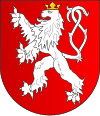Klodzko
| Kłodzko | |||
|---|---|---|---|

Gothic bridge and church
|
|||
|
|||
| Coordinates: 50°26′N 16°39′E / 50.433°N 16.650°E | |||
| Country |
|
||
| Voivodeship | Lower Silesian | ||
| County | Kłodzko County | ||
| Gmina | Kłodzko (urban gmina) | ||
| Established | 10th century | ||
| Town rights | 1233 | ||
| Government | |||
| • Mayor | Bogusław Szpytma | ||
| Area | |||
| • Total | 25 km2 (10 sq mi) | ||
| Highest elevation | 370 m (1,210 ft) | ||
| Lowest elevation | 300 m (1,000 ft) | ||
| Population (2006) | |||
| • Total | 28,249 | ||
| • Density | 1,100/km2 (2,900/sq mi) | ||
| Time zone | CET (UTC+1) | ||
| • Summer (DST) | CEST (UTC+2) | ||
| Postal code | 57-300, 57-303, 57-304 | ||
| Area code(s) | +48 74 | ||
| Car plates | DKL | ||
| Website | http://www.um.klodzko.pl/ | ||
Kłodzko [ˈkwɔt͡skɔ] (Czech: Kladsko; German: Glatz; Latin: Glacio) is a town in south-western Poland, in the region of Lower Silesia. It is situated in the centre of the Kłodzko Valley, on the Nysa Kłodzka river.
Kłodzko is the seat of Kłodzko County (and of the rural Gmina Kłodzko, although the town itself is a separate urban gmina), and is situated in Lower Silesian Voivodeship (from 1975–1998 it was in the former Wałbrzych Voivodeship). With 28,250 inhabitants (2006), Kłodzko is the main commercial centre as well as an important transport and tourist node for the area. For its historical monuments it is sometimes referred to as "Little Prague" (Polish: Mała Praga, German: Klein-Prag). Culturally and traditionally a part of Bohemia, administratively it has been a part of Silesia since 1763.
The area of present-day Kłodzko has been populated at least since the 1st century BC. There are several archaeological sites both in and around the town that indicate that there must have been a settlement located on the ancient Amber Road that conducted extensive trade relations with the Roman Empire.
...
Wikipedia



